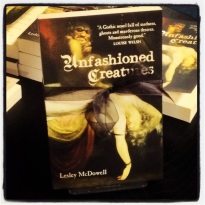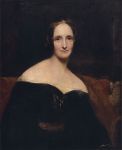 Lesley McDowell‘s Unfashioned Creatures is a gothic novel featuring Isabella Baxter Booth, who formed a close friendship with Mary Shelley during their formative teen years – when Mary began work on Frankenstein. In this guest post, Lesley tells us the story of why and how she wrote it.
Lesley McDowell‘s Unfashioned Creatures is a gothic novel featuring Isabella Baxter Booth, who formed a close friendship with Mary Shelley during their formative teen years – when Mary began work on Frankenstein. In this guest post, Lesley tells us the story of why and how she wrote it.
Where does the idea for a book come from? I wish the answer for this was straightforward, but instead it’s full of stops and starts and sideways manoeuvring. I’d originally planned to write a novel about Claire Clairmont, the step-sister of Mary Shelley, after reading about her in 1998. Claire captivated me with her spirit and adventurousness. She’d had an affair with Byron, borne his child, and worked as a governess in Russia after her only protector, Shelley, had died.
But I couldn’t write her into a novel somehow. Claire was a great diary-keeper and letter-writer which meant lots of lovely personal information, but no space for me to invent my version of her. After I’d completed a rough manuscript I wasn’t happy with, I remembered Mary Shelley’s stay in Dundee, from 1812-1814, with the Baxter family. Mary had grown very close to Isabella Baxter, who was also only about fourteen at the time. Isabella went on to marry her dead sister’s husband, who was thirty years older than her. That struck me as a dramatic, romantic and odd thing to do; subsequently her husband experienced bouts of madness.
In 1823, after Shelley had died in Italy and Mary had come back to London, she met up with Isabella, whom she hadn’t seen for some time. This meeting greatly disturbed Mary, although she never quite explained why. All she said was that if it wasn’t for the memory of happier times, she would have nothing more to do with Isabella who, she related in a letter to her friend Leigh Hunt, was “very disturbed in her reason.”
That was almost all I needed. I’d always loved Henry James’s The Turn of the Screw and the ambiguity surrounding the governess relating the tale – is she mad or does she really see ghosts? – was perfect for Isabella. Best of all, there was very little recorded in her own words – I had the space to imagine her as I wanted.
Then as I began to research the history of madness, I found the 1820s to be an extraordinary time, a time of real hope, of experimentation with new treatments for those “disturbed in their reason”. Practitioners of this new science truly believed they could ‘cure’ madness. A community at Gheel in Antwerp in Belgium also had a radical approach to treating madness.
Many things began to come together – the Scottish Enlightenment had thrown up all sorts of arguments about reason and what made humans human (the very question that leads us to a consideration of madness – if we lose our sanity, do we lose our ‘selves’?). I realised I needed a doctor’s narrative, and thought of Jean Rhys’s Wide Sargasso Sea, with its dual structure. I tried to follow the same pattern and tell the story from two points of view – Isabella’s, and that of a young doctor’s, with whom she comes into contact.
I hadn’t written from the point of view of a young man before and wasn’t sure I could do it. I initially made my male protagonist, Alexander Balfour, a very old man but soon realised too much was told in flashback, holding up the pace of the narrative. So I put him in the same time frame as Isabella, and that was that. The sparks started to fly.
Some small liberties with the facts are always necessary with historical fiction, but staying true to the ideas of the time is important. My Isabella is an invention that I’m sure would have horrified the real Isabella, but what matters is that she’s convincing. I want readers to believe in her, and in her story.
Lesley McDowell

